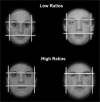Evidence from Meta-Analyses of the Facial Width-to-Height Ratio as an Evolved Cue of Threat
- PMID: 26181579
- PMCID: PMC4504483
- DOI: 10.1371/journal.pone.0132726
Evidence from Meta-Analyses of the Facial Width-to-Height Ratio as an Evolved Cue of Threat
Abstract
The facial width-to-height ratio (FWHR) is the width of the face divided by the height of the upper face. There is mixed evidence for the hypothesis that the FWHR is a cue of threat and dominance in the human face. We conducted a systematic review and meta-analyses of all peer-reviewed studies (and 2 unpublished studies) to estimate the magnitude of the sex difference in the FWHR, and the magnitude of the relationship between the FWHR and threatening and dominant behaviours and perceptions. Studies were eligible for inclusion if the authors reported an analysis involving the FWHR. Our analyses revealed that the FWHR was larger in men than in women (d = .11, n = 10,853), cued judgements of masculinity in men (r = .35, n of faces = 487; n of observers = 339), and was related to body mass index (r = .31, n = 2,506). Further, the FWHR predicted both threat behaviour in men (r = .16, n = 4,603) and dominance behaviour in both sexes (r = .12, n = 948) across a variety of indices. Individuals with larger FWHRs were judged by observers as more threatening (r = .46, n of faces = 1,691; n of observers = 2,076) and more dominant (r = .20, n of faces = 603; n of observers = 236) than those with smaller FWHRs. Individuals with larger FWHRs were also judged as less attractive (r = -.26, n of faces = 721; n of observers = 335), especially when women made the judgements. These findings provide some support for the hypothesis that the FWHR is part of an evolved cueing system of intra-sexual threat and dominance in men. A limitation of the meta-analyses on perceptions of threat and dominance were the low number of stimuli involving female and older adult faces.
Conflict of interest statement
Figures


References
-
- Parker GA. Assessment strategy and the evolution of fighting behaviour. J Theor Biol. 1974; 47:223–243. - PubMed
-
- Maynard Smith J, Harper D. Animal signals. New York, NY: Oxford University Press; 2003.
-
- Arnott G, Elwood RW. Assessment of fighting ability in animal contests. Anim Behav. 2009; 77:991–1004.
-
- Grueter CC, Isler K, Dixson BJ. Are badges of status adaptive in large complex primate groups? Evol Hum Behav. in press. 10.1016/j.evolhumbehav.2015.03.003 - DOI
Publication types
MeSH terms
LinkOut - more resources
Full Text Sources
Other Literature Sources

